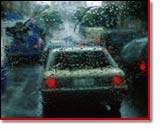There are a number of signals that should alert you that you are possibly losing your driving skills and need to examine your ability to maintain your current driving schedules. Ask yourself the following questions:
Have you come to dread the idea of driving during bad weather, or at night?
The deterioration of eyesight is an inevitable part of aging. Light absorption is reduced, which can create difficulty for senior drivers in the dark. It can seem as if headlights are coming right for you, the lines on the road are harder to distinguish, it is more difficult to orient yourself in relation to other vehicles, and the glare from other cars and neon signs is causing discomfort.
Do you find left-hand turns and busy intersections more difficult to navigate?
Many older drivers avoid left-hand turns by using a strategy of three right-hand turns instead. No evidence exists to prove that this is any safer. In fact, this approach has been questioned recently by experts who believe that the additional driving required for three right turns may increase the likelihood of an accident or getting lost -- particularly in unfamiliar territory.
There is nothing wrong with keeping away from traffic flows and intersections that cause you stress. But you should be aware that you are avoiding them because you find them increasingly difficult to navigate, and it may indicate a need for you to examine your other driving habits.
Have you noticed a change in the way other drivers behave?
Lately you've begun to think that other drivers have stopped paying attention to the rules. They drive too fast, tailgate, and have become more hostile, even at times when you are certain that you are obeying all the traffic laws and driving within the speed limit. Has it become more common for you to see another driver making angry gestures at you?
Is parking more difficult?
Parking your car used to be easy, whether it was parallel parking or in a parking lot. But now the angles are too complicated to negotiate and it's more and more difficult to see how close you are to other parked vehicles. Have you stopped trying to park parallel? Do you find parking difficult unless it is a diagonal spot in a parking lot?
Do other cars sometimes seem to appear from nowhere?
If your first awareness of another car  is when it is right in front of you, obviously you have had a serious lapse in observation. The danger is compounded when you don't have the strength to apply the right amount of pressure to the brakes. Being caught by surprise by another car can happen at anytime in a person's life, but has it been happening with more frequency?
is when it is right in front of you, obviously you have had a serious lapse in observation. The danger is compounded when you don't have the strength to apply the right amount of pressure to the brakes. Being caught by surprise by another car can happen at anytime in a person's life, but has it been happening with more frequency?
Has the number of near misses increased and does it seem as if pedestrians no longer obey the rules?
Near misses can happen to anyone of any age if the driver is distracted. Quick reflexes are crucial in these circumstances for the obvious reasons.
Do you forget your route?
Forgetfulness is common enough in older people, but does your memory loss include the routes you've been driving for years? Do you pass roads and intersections where you had intended to make a turn? Do you suddenly realize you don't know where you are supposed to be going, or have you suffered from disorientation because you found yourself in a strange place while driving a familiar route? You should immediately seek advice from your doctor if anything of this nature happens.
There are other warning signs you need to be aware of -- friends and families refusing to ride with you; lack of confidence behind the wheel; difficulty seeing signs and stoplights; feeling overwhelmed; trouble moving the steering wheel or moving your foot from pedal to pedal. Any skill that you had mastered but now seems elusive should be considered a cautionary signal that you need to evaluate your ability to drive.

